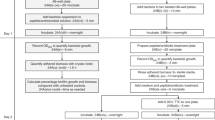Abstract
Antibacterial activity assays are an important tool in the assessment of the ability of one bacterium to kill or inhibit the growth of another, for example, during the study of the Type VI secretion system (T6SS) and the antibacterial toxins it secretes. The method we describe here can detect the ability of a bacterial strain to kill or inhibit other bacterial cells in a contact-dependent manner when cocultured on an agar surface. It is particularly useful since it enumerates the recovery of viable target cells and thus enables quantification of the antibacterial activity. We provide a detailed description of how to measure the T6SS-dependent antibacterial activity of a bacterium such as Serratia marcescens against a competitor prokaryotic organism, Escherichia coli, and describe possible variations in the method to allow adaptation to other attacker and target organisms.
Access this chapter
Tax calculation will be finalised at checkout
Purchases are for personal use only
Similar content being viewed by others
References
Gallegos-Monterrosa R, Coulthurst SJ (2021) The ecological impact of a bacterial weapon: microbial interactions and the Type VI secretion system. FEMS Microbiol Rev 45:1–18
Coulthurst S (2019) The type VI secretion system: a versatile bacterial weapon. Microbiology 165:503–515
Hernandez RE, Gallegos-Monterrosa R, Coulthurst SJ (2020) Type VI secretion system effector proteins: effective weapons for bacterial competitiveness. Cell Microbiol 22:1–9
Jurėnas D, Journet L (2021) Activity, delivery, and diversity of type VI secretion effectors. Mol Microbiol 115:383–394
Monjarás Feria J, Valvano MA (2020) An overview of anti-eukaryotic T6SS effectors. Front Cell Infect Microbiol 10
Shneider MM, Buth SA, Ho BT et al (2013) PAAR-repeat proteins sharpen and diversify the type VI secretion system spike. Nature 500:350–353
Russell AB, Hood RD, Bui NK et al (2011) Type VI secretion delivers bacteriolytic effectors to target cells. Nature 475:343–349
Schwarz S, West TE, Boyer F et al (2010) Burkholderia type VI secretion systems have distinct roles in eukaryotic and bacterial cell interactions. PLoS Pathog 6:e1001068
Gueguen E, Cascales E (2013) Promoter swapping unveils the role of the Citrobacter rodentium CTS1 type VI secretion system in interbacterial competition. Appl Environ Microbiol 79:32–38
Hachani A, Lossi NS, Filloux A (2013) A visual assay to monitor T6SS-mediated bacterial competition. J Vis Exp e50103
Alcoforado Diniz J, Coulthurst SJ (2015) Intraspecies competition in Serratia marcescens is mediated by type VI-secreted Rhs effectors and a conserved effector-associated accessory protein. J Bacteriol 197:2350–2360
English G, Trunk K, Rao VA et al (2012) New secreted toxins and immunity proteins encoded within the type VI secretion system gene cluster of Serratia marcescens. Mol Microbiol 86:921–936
Fritsch MJ, Trunk K, Diniz JA et al (2013) Proteomic identification of novel secreted antibacterial toxins of the Serratia marcescens type VI secretion system. Mol Cell Proteomics 12:2735–2749
Murdoch SL, Trunk K, English G et al (2011) The opportunistic pathogen Serratia marcescens utilizes type VI secretion to target bacterial competitors. J Bacteriol 193:6057–6069
Mariano G, Trunk K, Williams DJ et al (2019) A family of type VI secretion system effector proteins that form ion-selective pores. Nat Commun 10:5484
Hood RD, Singh P, Hsu FS et al (2010) A type VI secretion system of Pseudomonas aeruginosa targets a toxin to bacteria. Cell Host Microbe 7:25–37
Ma LS, Hachani A, Lin JS et al (2014) Agrobacterium tumefaciens deploys a superfamily of type VI secretion DNase effectors as weapons for interbacterial competition in planta. Cell Host Microbe 16:94–104
Alves JA, Leal FC, Previato-Mello M et al (2022) A quorum sensing-regulated type VI secretion system containing multiple nonredundant VgrG proteins is required for interbacterial competition in Chromobacterium violaceum. Microbiol Spectr 10:e01576–e01522
MacIntyre DL, Miyata ST, Kitaoka M et al (2010) The Vibrio cholerae type VI secretion system displays antimicrobial properties. Proc Natl Acad Sci 107:19520–19524
Trunk K, Peltier J, Liu YC et al (2018) The type VI secretion system deploys antifungal effectors against microbial competitors. Nat Microbiol 3:920–931
Casadaban M, Cohen S (1979) Lactose genes fused to exogenous promoters in one step using a Mu-lac bacteriophage: in vivo probe for transcriptional control sequences. Proc Natl Acad Sci U S A 76:4530–4533
Acknowledgments
This work was supported by Coordenação de Aperfeiçoamento de Pessoal de Nível Superior (CAPES, PhD studentship to J.A.D.) and Wellcome (Senior Fellowship to S.J.C., PhD studentship to REH).
Author information
Authors and Affiliations
Corresponding author
Editor information
Editors and Affiliations
Rights and permissions
Copyright information
© 2024 The Author(s), under exclusive license to Springer Science+Business Media, LLC, part of Springer Nature
About this protocol
Cite this protocol
Alcoforado Diniz, J., Earl, C., Hernandez, R.E., Hollmann, B., Coulthurst, S.J. (2024). Quantitative Determination of Antibacterial Activity During Bacterial Coculture. In: Journet, L., Cascales, E. (eds) Bacterial Secretion Systems . Methods in Molecular Biology, vol 2715. Humana, New York, NY. https://doi.org/10.1007/978-1-0716-3445-5_37
Download citation
DOI: https://doi.org/10.1007/978-1-0716-3445-5_37
Published:
Publisher Name: Humana, New York, NY
Print ISBN: 978-1-0716-3444-8
Online ISBN: 978-1-0716-3445-5
eBook Packages: Springer Protocols




